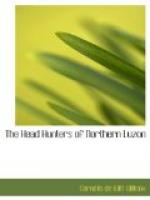In further proof of the local civilization, the women
wear false hair. One matron was obliging enough
to undo her coiffure for our benefit, and held out
by its end, for our admiring inspection, a mighty
wisp nearly three feet long. She put it back on
for us after the manner, as I have since been informed,
of a coronet braid. The men gave fewer evidences
of civilization, unless smoking cigars in holders
will serve. However, one man brought up his wife
and children and regularly introduced them to us, the
woman doing her part with great coolness, while the
children gave every sign of terror. This incident
struck me as being very unusual. Everyone had
on at least one necklace, and some three or four necklaces,
of dog-teeth, of agate beads (these being immensely
prized, agate not being native to the Philippines),
or of anything else the form, color, and hardness of
which could make it answer for purposes of ornament.
One young woman had on sleigh-bells, the tinkle of
which we heard before we saw its source, an incongruous
sound in those parts. These bells must have been
brought down by Chinese trading from the plains of
Manchuria. Two or three young men displayed what
looked like lapis lazuli around their necks, but what
turned out at closer quarters to be pieces of a blue
china dinner-plate. They had cut out the white
interior and then divided the rim radially, the jewels
thus formed being all of the same size and shape,
with perfectly smooth edges. Here, too, were the
same pill-box hats as those seen at Bontok, some elaborately
beaded and costing from one to five carabaos apiece;
in one case the lid of a tomato tin had been pressed
into service as a hat. But the finest thing of
all was the head-ax, a beautiful and cruel-looking
weapon, the head having on one side an edge curving
back toward the shaft, and on the other a point.
To keep the weapon from slipping out of the hand,
a stud is left in the hard wood shaft, about two-thirds
of the way from the head, the shaft itself being protected
by a steel sheathing half way down; the remainder
being ornamented with decorative brass plates and
strips, and the end shod in a ferrule of silver.
The top of the ax is not straight, but curved, both
edge and point taking, as it were, their origin in
this curve; the edge is formed by a double chamfer,
the ax-blade being of uniform thickness. All together,
this weapon is perhaps more original and characteristic
than any other native to the Philippine Archipelago.
With it goes the Kalinga shield of soft wood, made
in one piece, with the usual three horns or projections
at the top and two at the bottom. These projections,
however, are cylindrical, and the outside ones are
continued down the edge of the shield and so form
ribs. In the ordinary Igorot shield the horns
are flat, merely prolonging the surface of the shield,
or else presenting only a very small relief.
As usual, a lacing of bejuco across top and
bottom protects the shield against a separation in
the event of an unlucky stroke splitting it in two.




